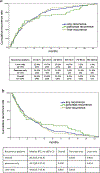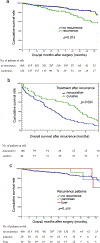Resection of pancreatic neuroendocrine tumors: defining patterns and time course of recurrence
- PMID: 31235429
- PMCID: PMC10182895
- DOI: 10.1016/j.hpb.2019.05.020
Resection of pancreatic neuroendocrine tumors: defining patterns and time course of recurrence
Abstract
Background: To define recurrence patterns and time course, as well as risk factors associated with recurrence following curative resection of pNETs.
Method: Patients who underwent curative-intent resection for pNET between 1997 and 2016 were identified from the US Neuroendocrine Tumor Study Group. Data on baseline and tumor-specific characteristics, overall survival (OS), timing and first-site of recurrence, predictors and recurrence management were analyzed.
Results: Among 1020 patients, 154 (15.1%) patients developed recurrence. Among patients who experienced recurrence, 76 (49.4%) had liver-only recurrence, while 35 (22.7%) had pancreas-only recurrence. The proportion of liver-only recurrence increased from 54.3% within one-year after surgery to 61.5% from four-to-six years after surgery; whereas the proportion of pancreas-only recurrence decreased from 26.1% to 7.7% over these time periods. While liver-only recurrence was associated with tumor characteristics, pancreas-only recurrence was only associated with surgical margin status. Patients undergoing curative resection of recurrence had comparable OS with patients who had no recurrence (median OS, pancreas-only recurrence, 133.9 months; liver-only recurrence, not attained; no recurrence, 143.0 months, p = 0.499) CONCLUSIONS: Different recurrence patterns and timing course, as well as risk factors suggest biological heterogeneity of pNET recurrence. A personalized approach to postoperative surveillance and treatment of recurrence disease should be considered.
Copyright © 2019 International Hepato-Pancreato-Biliary Association Inc. Published by Elsevier Ltd. All rights reserved.
Conflict of interest statement
Conflicts of interest
None declared.
Figures



References
-
- Chi W, Warner RRP, Chan DL, Singh S, Segelov E, Strosberg J et al. (2018) Long-term outcomes of gastroenteropancreatic neuroendocrine tumors. Pancreas 47:321–325. - PubMed
-
- Franko J, Feng W, Yip L, Genovese E, Moser AJ. (2010) Non-functional neuroendocrine carcinoma of the pancreas: incidence, tumor biology, and outcomes in 2,158 patients. J Gastrointest Surg 14:541–548. - PubMed
-
- Kuo EJ, Salem RR. (2013) Population-level analysis of pancreatic neuroendocrine tumors 2 cm or less in size. Ann Surg Oncol 20: 2815–2821. - PubMed
-
- Bilimoria KY, Talamonti MS, Tomlinson JS, Stewart AK, Winchester DP, Ko CY et al. (2008) Prognostic score predicting survival after resection of pancreatic neuroendocrine tumors: analysis of 3851 patients. Ann Surg 247:490–500. - PubMed
MeSH terms
Grants and funding
LinkOut - more resources
Full Text Sources
Medical

